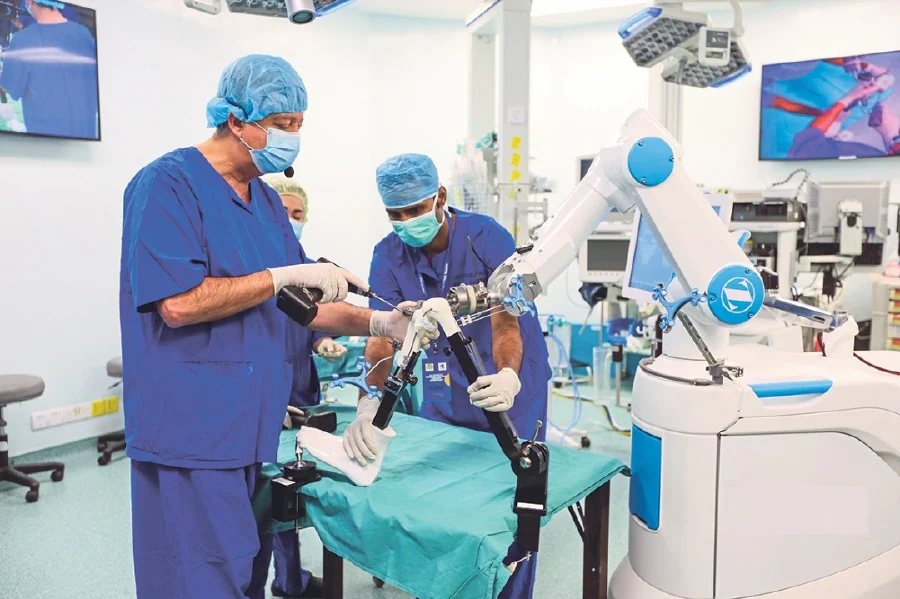By Shantanu Mukherjee and Hrishika Girijan
INTRODUCTION
OpenAI’s[1] chatbot, ChatGPT, has been the talk of the tech town for over a week. More than a million people signed up to test it, and hundreds of screenshots of ChatGPT conversations went viral soon after. Since then, it’s been called a Google[2] Killer, banned by the popular programming forum Stack Overflow[3] for inaccuracy, and stunned the world with its ability to do everything from write functional code to make medical diagnoses, to give directions in the style of the King James Bible on how to remove a peanut butter sandwich from a VCR (“..verily I say unto thee, seek not to put thy peanut butter sandwiches in the VCR..”).
Artificial Intelligence applications in healthcare have come a long way since we first started integrating AI and healthcare in the 1950s, with the first documented use being Eliza, a psychotherapist chatbot developed in 1964 at the MIT AI Lab by Joseph Weizenbaum. As computer processing speeds and storage have increased and available data sets to train AI on have exploded in size, AI research, development and adoption has quietly accelerated.
Today, AI has applications in different fields of healthcare, including diagnosis, surgery and rehabilitation, drug discovery, telehealth and data management. This article is part 1 of a series of pieces on ‘AI and Healthcare’, through which we analyse how AI is transforming healthcare, the legal and ethical issues involved, and how governments around the world are struggling to regulate AI.
USE CASES IN AI
From analyzing complex datasets to performing repetitive actions in surgery without fatigue the use of AI in healthcare, as we know it today, is vast. The adoption of AI at every stage of healthcare right from consultation, and diagnosis to surgery has modernized medical treatment and improved patient experience. We shall discuss some of these applications below.
1. Digital Consultation
Due to the need for increased access to healthcare during and in the aftermath of the pandemic, digital consultation progressed rapidly. According to McKinsey and Co. (2022),[4] the number of patients in the U.S. opting for teleconsultations has increased substantially with telehealth solutions being used 38 times more than before the pandemic.
AI can help the existing infrastructure by interpreting and organizing complex data, combatting misinformation, personalizing medication, and optimizing resource management. One example of this is Buoy AI, which was developed by a Harvard Medical student. Buoy AI is an interactive symptom-checking chatbot that uses predetermined responses to prompt patients to choose options based on their health concerns. It even suggests consultation with a human doctor when required and offers a list of clinics close to the user’s location. Xiaoyi, an AI-powered Chinese robot developed by iFlyTek collects and analyses patient information and improves efficiency by assisting human doctors. It made history by being the first robot in the world to pass the Chinese National Medical Licensing Examination making it eligible to be a licensed medical practitioner. During the pandemic, Haptik AI and the Indian government collaborated to develop the MyGov Corona Helpdesk, a WhatsApp chatbot, that was used to issue alerts, inform, and respond to queries regarding the Covid-19 virus.
2. Diagnosis
Lately, the use of AI in medical diagnosis has helped in the early detection of cancer, the prediction of strokes, and the prioritization, and management of chronic illnesses. Around 75% of the 521 AI tools authorized by the FDA in 2022 have been in radiology while 11% have been in cardiology.[5] The main reason for such concentration is the availability of large amounts of data in these fields.
Some examples of how the field of radiology has benefitted the most from the use of AI are – Ezra AI, which schedules MRI scans and analyses them for early cancer detection, the Netherland-based SkinVision app, which can detect skin cancer from user-uploaded images, and EuroSafe Imaging that promotes medical radiation protection by estimating radiation risks. PIVOT is an AI-based tool developed by researchers at IIT Madras, for the early detection of Breast invasive Carcinoma, Colon Adenocarcinoma, and Lung Adenocarcinoma.
Several top companies such as Siemens Healthineers, and GE Healthcare have received FDA authorizations for their AI-enabled devices. Most of the approved GE Healthcare devices are in radiology which includes devices that use algorithms to detect lung cancer, and devices that help improve the quality of MRI images. Siemens was granted authorisation for a device that uses an algorithm to accurately image calcified coronary lesions from CT scans. Aidoc, Canon Medical Systems, and Philips are some other companies that have received such authorizations.
3. Surgical Intervention
Surgery is a field of medicine that is most prone to human errors. One study [6] suggested that over 50% of adverse events in surgeries were caused by human performance deficiencies. AI-assisted surgeries can help improve patient outcomes. For instance, the FDA-approved UNiD Spine Analyzer software, developed by Medtronic Inc. an American healthtech company, helps surgeons plan for degenerative spinal procedures, reducing the risk of further degeneration. Minimally invasive procedures such as robotic knee surgery can be performed in less than 45 minutes and help in lessening surgical trauma.
AI-enabled robots such as the Da Vinci, developed by Intuitive Surgical, can be controlled remotely to perform minimally invasive surgeries with accuracy and precision. The FDA-approved CyberKnife technology invented by physicians, physicists, and engineers at Stanford Health Care, provides focused non-invasive radiation that helps in destroying tumour cells and stopping the growth of active tissue. AI can also improve efficiency by providing information such as the size of a tissue, as in the case of a laparoscopic AI robot developed by Asensus Surgical.
4. Research And Development (RnD)
Transforming existing procedures in the healthcare industry is very crucial toserving the changing times. AI systems aid in the same by developing more cost-efficient, fast, but accurate tools that can interpret complex data structures with ease. The canSAR database developed by the Institute of Cancer Research UK, can plough through a pile of scientific literature, clinical data and patient genetic data, and correlate the two to make significant cancer-drug discovery predictions. Sanofi, a multinational AI-driven healthcare company has entered into a $21.5 million alliance with Insilico Medicine for the use of Insilico’s AI platform and its scientists, for drug discovery and research.
Focusing on faster healthcare breakthroughs, Cleveland Clinic has collaborated with IBM on the Discovery Accelerator that uses AI to boost research in the areas of population health, genomics, and drug discovery. Karkinos Healthcare, an Indian tech-based healthcare delivery platform, uses AI to analyze data for the development of accessible and affordable cancer care solutions.
5. Mental Health
Traditional psychiatric and psychological treatments depend on the use of verbal language to understand and measure mental health progress. However various AI-enabled techniques such as the Naïve-Bayes, Support Vector Machines can detect one’s emotions from text processing, helping in detecting depression and anxiety. Kintsugi Voice, a women owned startup focusing on mental health, and Sonde Health, a company focused on preventive healthcare, provide AI solutions that use voice biomarkers to detect depressive symptoms. AI used by Kintsugi can dissect a 20-second voice clip to interpret audio indications of distress, while Sonde helps to transform any device into a health device using its in-built microphone feature to detect signs of distress in speech.
Research[7] published in the Lancet shows that there has been a nearly 35% increase in the prevalence of mental health disorders during the Covid-19 pandemic. AI can help in expanding mental health resources through chatbots such as WoeBot which is an AI-powered conversational agent that monitors mood and manages anxious thoughts by providing therapeutic solutions. It can be used by individuals and organizations alike, and its simple setup process and user-friendly interface make it easily accessible. According to a 2022 survey conducted by Deloitte India,[8] 80% of the Indian workforce have faced mental health issues over the period of 2021-2022 and 47% of professionals link their issues to workplace-related stress. AI technology as used by Spring Health, a healthcare provider striving to eliminate mental health barriers in organisations, can aid in improving employee wellbeing by helping employers provide mental health resources to their employees.
FUTURE APPLICATIONS OF AI
Owing to the growing population, lifestyle changes, and the onset of the pandemic, the volume, and need for access to healthcare have increased rapidly. The use of AI can help in making medical resources accessible to a larger population and in providing personalized medical care to patients. According to Tom Lawry, the National Director of AI for Health & Life Sciences at Microsoft, a major promise of AI in the healthcare industry is to reduce physician and staff burnout which arose as a serious concern, especially during the pandemic era.[9]
AI such as Olive AI can be used to automate high-volume repetitive tasks accurately and timely thereby streamlining workload and improving personnel efficiency. They have partnered with more than 200 enterprise customers providing insurance, healthcare systems, etc. to help resolve persistent difficulties in the healthcare system.
Governments too have realized the power of AI and seized the opportunity to provide healthcare equitably. For instance, the Singapore government through its Integrated Diabetic Retinopathy Program (SiDRP) has used SELENA+ (Singapore Eye LEsioN Analyzer), a deep learning system for national-level screening of diabetic retinopathy to combat diabetes which is a prevalent health concern in Singapore.
The World Economic Forum (WEF) has reported[10] that by 2030 AI would change the healthcare industry in 3 ways:
a. Full-fledged AI-powered predictive care: AI would detect when a person could develop a chronic illness by studying the social determinants that affect their health and suggest ways in which it could be prevented. Today, we have platforms focused on prevention such as Babylon that constantly monitor user health, assess risk factors, and provide new and advanced medical information to patients. Currently, they cater to over 24 million people worldwide. More such platforms are likely to emerge in the coming future.
b. Digital infrastructures connecting care: Hospitals would function focusing only on extremely urgent cases while the lesser urgent cases would be addressed via smaller retail clinics or even remotely. This would help in ensuring that severe cases receive the most immediate attention from doctors and physicians.
c. Improved experiences: By 2030, AI would help in enhancing the experience of both patients and clinicians by reducing wait time and taking on administrative burdens, respectively. Platforms such as Qventus Inc., which help in reducing waiting times, mapping the quickest ambulance routes, triaging patients, and solving other operational difficulties, are likely to be more prevalent in the coming future.
CONCLUSION
While AI certainly has the potential to revolutionize healthcare, it comes with its own ethical and legal challenges. When a machine makes diagnostic decisions, who is liable if the machine errs, causing patient harm? If an algorithm is only trained on a data set of relatively homogenous patients, will it display implicit bias when used in more heterogeneous populations?
In Part 2[11] of our series on “AI in Healthcare”, we will dive into these and other issues at the frontiers of digital health.
[1]https://www.linkedin.com/company/openai/
[2]https://www.linkedin.com/company/google/
[3]https://www.linkedin.com/company/stack-overflow/
[4]https://www.mckinsey.com/industries/healthcare-systems-and-services/our-insights/telehealth-a-quarter-trillion-dollar-post-covid-19-reality
[5]https://www.fda.gov/medical-devices/software-medical-device-samd/artificial-intelligence-and-machine-learning-aiml-enabled-medical-devices%20https:/www.medicalbuyer.co.in/five-takeaways-from-the-fdas-list-of-ai-enabled-medical-devices/
[6]https://jama.jamanetwork.com/article.aspx?doi=10.1001/jamanetworkopen.2019.8067&utm_campaign=articlePDF%26utm_medium=articlePDFlink%26utm_source=articlePDF%26utm_content=jamanetworkopen.2019.8067
[7]https://doi.org/10.1016/S0140-6736(21)02143-7
[8]https://www2.deloitte.com/in/en/pages/life-sciences-and-healthcare/articles/mental-health-press-release-2022.html
[9]https://www.insideprecisionmedicine.com/book-review/hacking-healthcare-how-ai-and-the-intelligence-revolution-will-reboot-an-ailing-system
[10]https://www.weforum.org/agenda/2020/01/future-of-artificial-intelligence-healthcare-delivery[11]https://www.roninlegal.in/post/artificial-intelligence-in-healthcare-part-2















